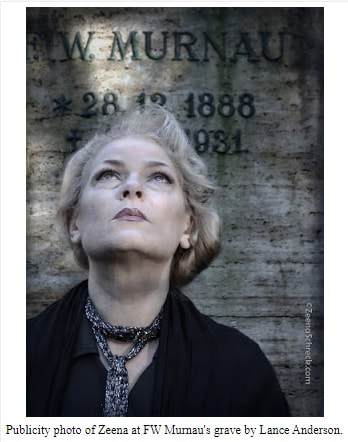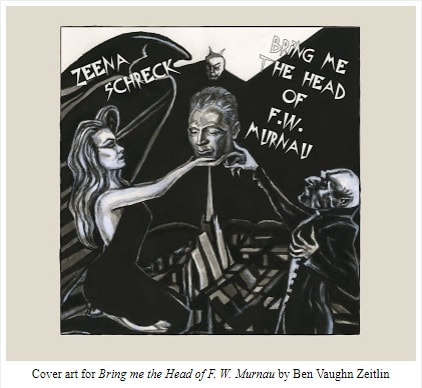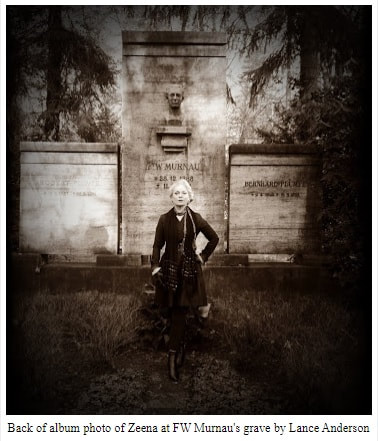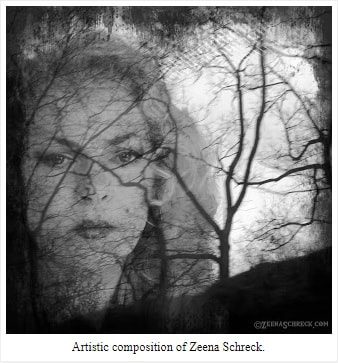Many thanks to Nicholas Diak for this fantastic review and exclusive interview with Zeena about her new music! [Re-posted below from the original at Heilige Tod - Interdisciplinary Analysis of Neofolk Music.]Bring Me the Head of F.W. Murnau can be purchased digitally at Bandcamp or in physical format at this site. Review and Interview: Zeena Schreck and her debut Bring Me the Head of F. W. Murnau Tuesday, August 4, 2020 by Nicholas Diak During the summer of 2015, the skull of German silent film director F. W. Murnau was stolen from his tomb. Remnants of wax from lit candles present at the scene spurred the hypothesis that occult work was afoot while the macabre nature of Murnau’s stolen skull drew parallels to his legendary horror output, in particular his influential expressionist film, Nosferatu, eine Symphonie des Grauens (1922).(1) Shortly thereafter, inspired by the event, multimedia artist Zeena Schreck announced a “sequel to Radio Werewolf’s mystical, musical piece Bring Me the Head of Geraldo Rivera” that would be appropriately titled Bring Me the Head of F. W. Murnau.(2) Five years later, Bring Me the Head of F. W. Murnau (BMTHOFWM) was released in March of 2020. BMTHOFWM marks the first studio release proper of Zeena performing music solo. Prior to this EP, Zeena had been a part of many musical collaborations and projects, such as Radio Werewolf, and had released some of her live ritual performances, such as her appearance at Wave-Gotik-Treffen, on compilations and YouTube. Per Zeena in regard to releasing a concept album instead of an album of her ritual performances: “I definitely have future recording plans which will be in the areas of dark ambient and ritual music. [T]his first solo release was experimental in the sense I'd never done such a precise theme as concept album like this before. I like working within specific parameters though. Even in past recordings, when it might not seem obvious, I've almost always had in mind a particular framework within which to create the music. But this album was much more of a specific theme than I would normally do.”(3) BMTHOFWM certainly has a thematic laser focus, concentrating on Murnau and some of his films, while capturing a certain silent film aesthetic, though paradoxically, with sound. Zeena pulls this feat off – a silent film with no images but instead with sounds – by incorporating elements of field recordings, minimalist-industrial, exotica, spoken words, and incantations, in conjunction with the brilliant German expressionist/Caligari style artwork that emblazons the release’s cover art that evokes some of the classic horror posters of the era. Though Murnau is the subject of the EP, the filmmaker did not have a strong influence on Zeena at the beginning of the project: “[Murnau was] not a huge influence. It was only his films Nosferatu and Faust that I had known and really liked since childhood, when they'd play on late night TV. I knew he'd worked with the occultist artist/architect Albin Grau on the sets for Nosferatu but working with an occultist doesn't automatically make you one. There is also the tie-in of my last name being the same as the actor who played Count Orlok, Max Schreck, in Murnau's most famous film Nosferatu. I'd also remembered the scandalous rumors about his untimely death that my godfather Kenneth Anger wrote of in Hollywood Babylon, rumors which, by the way, I've since learned weren't true. But aside from these things, I hadn't much knowledge of his life prior to embarking on this project. I know far more about him now. Originally, I'd planned that this [release] was only going to be a single; not more than a two-track novelty piece inspired by a quirky event. But then, as I began researching more about Murnau and put flesh on the bones of this project, certain metaphysical portals started opening up. More material for more tracks developed than could be narrowed down to just a single. Yet I didn't want this to be a full album either. So, the logical middle ground was to make it an EP.”(4) Through the process of researching Murnau, Zeena also visited the director’s home and his grave, gathering field recordings that would be incorporated into the compositions of BMTHOFWM: “[I] intermingled various sounds from both locations in just about every track except the opening one, ‘Letter to Mother.’ Some of those field recordings were used in a straightforward manner, such as a fox barking, birds singing, the sound of some machinery or a metal gate clanging. Those can be detected fairly clearly enough. But other sounds used, I distorted in the editing to achieve certain auditory effects. When I visited Murnau's grave, for the photo shoot to the CD, I was focused on getting the photos but hadn't intended on capturing field recordings at the same time. I'd already compiled field recordings taken at the former Murnau house in Berlin, which coincidentally happens to be right in my neighborhood. In addition to that, I'd painstakingly searched for specific samples corresponding to the exact years of Murnau's creative life and his death, such as the sound of the precise year and make of the car he was in when it crashed, leading to his death. Or a snippet of a song that would've been popular at parties in Hollywood that he may have attended. Things like that.  So, getting back to the cemetery field recordings: It was only by fluke, while taking photos at Murnau's grave, that my camera accidentally engaged the video record. It wasn't until later that day, when downloading my data from the day's shoot, I realized I'd inadvertently gotten some unexpected and pretty interesting sounds while at the grave. Luckily, there was still time to mix those in before the final edit and mastering. For some unknown reason, I've always had strange energy clashes with electronic devices; something's always malfunctioning with them in my case. I've come to expect these ‘accidental’ recordings of environment sounds, with both my audio recorder and my cameras video setting. Whenever it happens, I always discover something interesting, humorous or just uncanny and bizarre that gets added to my sound library. This reveals how much is occurring all the time that we humans normally filter out but which, when cut out of the normal flow of everyday life, can be wonderful auditory meditations. I'm sure that those unexpected sounds at the cemetery made a difference in enhancing an underlying eerie quality to the whole thing.”(5) Zeena’s field recordings directly tie into her concept of “sonic necromancy.” These field recordings she gathered communicate an additional essence of Murnau that would not have been present otherwise: “Sound art differs from conventionally composed music in that soundscapes are generally thought to be like paintings done with sound rather than matter. They may or may not necessarily tell a story. In this case, however, there is story. Between many years of magical ritual practices, as well as early-life theater and film training, which includes techniques in character development, sense memory and improvisation, a fusion of disciplined training in all these areas creates conducive conditions for summoning of the dead. While my magical training and ritual experience is probably more generally acknowledged than my theater training, I mention the latter only in relation to this music project because I'm playing various characters or roles throughout. Whether we are hearing Murnau's own thoughts in the opening and closing tracks, or the female Angel of Death who's come to usher Murnau away from this worldly experience, or the ‘bardo beings’ who inhabit the intermediate state between the end of one life and the beginning of the next. All of those voices are different characters revealing different levels of metaphysical existence and understanding.”(6) If BMTHOFWM sounds like a multifaceted release, it is because it certainly is. Though the EP only contains six tracks and clocks in at roughly 18 minutes, it is compact in its sound design, atmosphere, and ambitious scope. The first track of the EP, “Letter to Mother,” has Zeena reciting a letter Murnau wrote to his mother against a background of crashing waves. In this track, Zeena channels her aforementioned acting chops, mimicking a deeper voice that would be Muranu. It is a somber recital that sets a melancholy mood that permeates the release. Track two, “Ill Omens,” runs with this melancholy with a peppering of something menacing or foreboding. It is a track that is minimal on sound, but high on atmosphere. Closing one’s eyes, one can picture an old film with a scene of tiptoeing through a cave or a dimly lit forest, illuminated day-for-night style, while a Harryhausen-esque monster waiting to emerge from the shadows. The third track, “A Drive up the Coast,” chronicles the last moments of Murnau as he died in an auto accident while traversing the Pacific Coast Highway near Santa Barbara in 1931. The track begins jovial, with organ music composed by Zeena that evokes a funfair or a period appropriate party in the background. Sounds of an open car window woosh by before (spoiler alert!) the sounds of accelerations, followed by a scream, tires screeching, and a crash. Track four, “Tabu,” is a reference to Murnau’s final film, Tabu: A Story of the South Seas (1931) that was released shortly after his death. An early tiki film, the story depicts two lovers, Reri and Matahi, as they try to escape Reri’s fate of being made into a sacred maiden for their island’s deities. The first half of the song is the most industrial-sounding music on the EP, with some minimalist piston-percussions. The last half of the song switches gears to the exotica genre, with primitive drumming and shakers, that channels the likes of Martin Denny and Les Baxter. Over the music, Zeena, reaching into her experience of performing incantations, recites the same decree that was uttered in Tabu that denoted Reri as forbidden, and not to be touched by any man. “The Phantom Bridge” is the EP’s fifth track and this one digs right into the vampiric roots Murnau is best known for. A spoken word track, Zeena recites some of the inter titles from Murnau’s Nosferatu which in turn were taken from Stoker’s Dracula. The music in this track is, as the title suggests, ghostly, with spirituals wisps, shackling noises, tiny bells and chimes. The EP’s final track, “Endlich Daheim,” is perhaps the most ambitious track on the album, that not only underscores Murnau’s career, but demonstrates Zeena at her most artistic. Prior songs on the EP has Zeena reciting texts from other sources while “Endlich Daheim” contains both original organ music and lyrics by Zeena, sung in a haunting and beautiful style. A sound of a 1920s projector starting up beings the track with the music proper evoking the feelings of being at a funeral - Murnau’s funeral - with Zeena’s poetry acting as a eulogy. The end result is that BMTHOFWM is a superb solo debut for Zeena and an excellent experimental release all around. Atmospheric, haunting, and magical, but also cinematic and fully versed in filmic pop culture that it celebrates. Born from a macabre act of stealing the skull of Murnau, the EP easily could’ve embraced grotesquery or morbidness, but instead the CD comes off as sincere. Aside from these observations, Zeena herself had her own goals for the release: “Well, after a few years of unexpected obstacles, as well as unexpected serendipitous occurrences which led to creating much more material for this than I'd originally planned, I guess the main thing I wanted to accomplish was getting it completed at all! Jokes aside, the fact is, there's still someone out there who has taken and kept the skull from Murnau's grave. This is at the heart of the project. I wanted to pull all of the unusual elements surrounding this case together into one cohesive creative expression. The music in this project is created to facilitate opening the mind to all possible questions surrounding that event, and even to, on a transcendental and metaphysical level, provide even bigger answers.”(7) Five years after the act, the mystery of who absconded with Murnau’s skull remains unsolved. Of course, thoughts have drifted to Schreck as a possible culprit, which she both playfully and adamantly dismisses: “[S]ince many have already jokingly asked me – let's nip this in the bud right here – NO, it wasn't me!”(8) Sincere thanks for Zeena Schreck for allowing me to interview her for this writeup and providing the images. All images used in this article are copyrighted by Zeena Schreck and used with permission. More information about Zeena and her projects can be found at the following websites and social medias:
Website: https://www.zeenaschreck.com/ Facebook: https://www.facebook.com/ZEENA.Official.ZeenaSchreck/ Instagram: https://www.instagram.com/zeenaschreck_art/ Bandcamp: https://zeenaschreck.bandcamp.com/releases YouTube: https://www.youtube.com/user/ZeenaSchreckOfficial Endnotes 1. Nigel M Smith, “Nosferatu director’s head stolen from grave in Germany,” The Guardian, last modified July 14, 2015, https://www.theguardian.com/film/2015/jul/14/nosferatu-director-head-stolen-germany-grave-fw-murnau. 2. “Coming Soon From Zeena Schreck: Bring Me The Head of F.W. Murnau,” Heathen Harvest, last modified July 21, 2015, https://heathenharvest.wordpress.com/2015/07/21/coming-soon-from-zeena-schreck-bring-me-the-head-of-f-w-murnau/. 3. Zeena Schreck, email message to author, June 16, 2020. 4. Ibid. 5. Ibid. 6. Ibid. Bibliography “Coming Soon From Zeena Schreck: Bring Me The Head of F.W. Murnau.” Heathen Harvest. Last modified July 21, 2015. https://heathenharvest.wordpress.com/2015/07/21/coming-soon-from-zeena-schreck-bring-me-the-head-of-f-w-murnau/. Schreck, Zeena. Bring me the Head of F. W. Murnau. KCH KCHCD01. 2020. CD. Smith, Nigel M. “Nosferatu director’s head stolen from grave in Germany.” The Guardian. Last modified July 14, 2015. https://www.theguardian.com/film/2015/jul/14/nosferatu-director-head-stolen-germany-grave-fw-murnau. Posted by Nicholas Diak at 6:58 PM
0 Comments
Your comment will be posted after it is approved.
Leave a Reply. |
SUPPORT FOR WORKS IN PROGRESS
Zeena is an entirely independent, self-funded artist. Her livelihood and funding for creative projects rely solely on commissioned artwork, teaching and lecturing engagements, performances and purchases of her products and music, as well as from donations from private patrons and sponsors. If you would like to pledge your support towards the production costs of current works in progress, please use the PayPal donation button at the top of page. Thank you for your support of Zeena's work! Archives
May 2024
Categories
All
|
Zeena's Bandcamp page |
Copyright ©2024 Zeena Schreck. All rights reserved.
|



